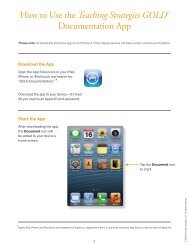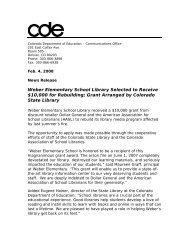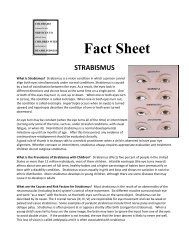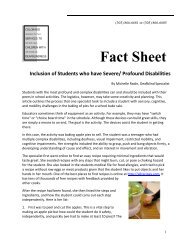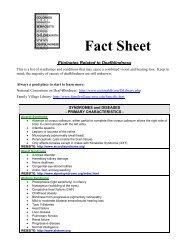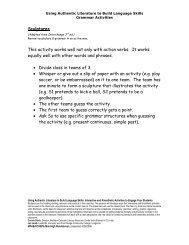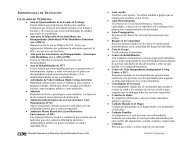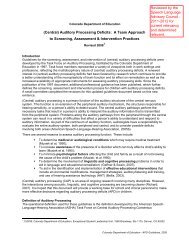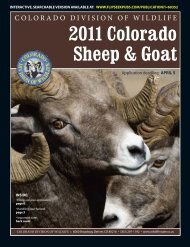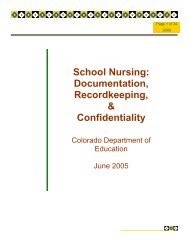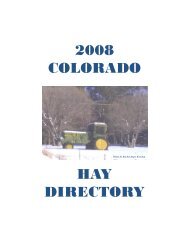ONLINE EDUCATION INTERIM REPORT - Colorado Department of ...
ONLINE EDUCATION INTERIM REPORT - Colorado Department of ...
ONLINE EDUCATION INTERIM REPORT - Colorado Department of ...
Create successful ePaper yourself
Turn your PDF publications into a flip-book with our unique Google optimized e-Paper software.
10<br />
the State Board <strong>of</strong> Education with the supervision<br />
<strong>of</strong> the educational system, and this duty has been<br />
carried out in several areas, including:<br />
• State accreditation <strong>of</strong> school districts<br />
• Implementation <strong>of</strong> the CSAP and the<br />
School Accountability Reports (SAR)<br />
• Establishment <strong>of</strong> 13 state model content<br />
standards, and<br />
• Implementation <strong>of</strong> the federal education<br />
law, No Child Left Behind (NCLB)<br />
These state-administered systems are balanced<br />
with strong local control. Because few other<br />
states place such an emphasis on local authority<br />
for education delivery, the task force recommends<br />
that any comparisons with other states’ online<br />
education systems should consider the degree to<br />
which those states’ local control governance is<br />
similar to <strong>Colorado</strong>’s.<br />
Public School Choice<br />
In addition, <strong>Colorado</strong> has a long tradition <strong>of</strong><br />
public school choice. For nearly 20 years, state<br />
law has allowed inter-district open enrollment,<br />
which means that a student can choose to enroll<br />
in any school district with available slots. About<br />
43,000 students cross district boundaries to<br />
enroll in a public school <strong>of</strong> their choice outside<br />
their local district. For over a decade, the state<br />
has had a charter school law allowing innovative<br />
schools that parents and communities demand<br />
to meet particular learning needs. This year,<br />
more than 48,300 students are enrolled in<br />
charter schools. Also, many districts have intradistrict<br />
open enrollment programs through<br />
which families can choose their preferred<br />
school within their local district. For example,<br />
in Denver approximately one third <strong>of</strong> students<br />
attend a school <strong>of</strong> their choice instead <strong>of</strong> their<br />
neighborhood school.<br />
Nearly a decade old, <strong>Colorado</strong>’s online education<br />
law builds on these public school choice options.<br />
About 8,236 students were enrolled in online<br />
schools in the fall <strong>of</strong> 2006. While online school<br />
enrollment has increased by 46% in the last<br />
couple <strong>of</strong> years, from 5,638 in 2005-06 to 8,236<br />
in 2006-07, the number <strong>of</strong> students enrolling<br />
in online schools lags the number <strong>of</strong> students<br />
that open enroll in physical schools or enroll<br />
in charter schools. It is also important to note,<br />
that Hope’s enrollment growth accounts for 88%<br />
<strong>of</strong> total online school enrollment growth, as its<br />
student population grew from 1,516 in 2005-06<br />
to 3,804 in 2006-07.<br />
School Finance<br />
School districts in <strong>Colorado</strong> are funded through a<br />
Per Pupil Revenue (PPR) formula that combines<br />
local property taxes with state funding to<br />
meet a base amount. The base amount is then<br />
supplemented with two main funding factors<br />
that take into consideration the size <strong>of</strong> the school<br />
district and the percentage <strong>of</strong> “at-risk” students.<br />
As mentioned previously, the state fi nance<br />
system defi nes “at-risk” according to their share<br />
<strong>of</strong> enrolled free lunch-eligible students. The<br />
current base amount is $4,863.87 and with the<br />
amount given for factors, the state average PPR<br />
is $6,359.11. After adding the factors, the state’s<br />
lowest funded district is $5,865.00, which is<br />
called the “minimum” amount. This is the amount<br />
that online schools receive for full-time online<br />
students and this dynamic will be analyzed in the<br />
funding section on pages 20-21.<br />
Finally, state law restricts funding for online<br />
students by requiring them to have been enrolled<br />
in a public physical school for at least one<br />
semester during the previous year (State Board <strong>of</strong><br />
Education Rule 301-56). This restriction allows<br />
for certain exemptions, but its constitutionality<br />
has been questioned from many people who<br />
argue that it may violate the constitutional<br />
requirement that education in <strong>Colorado</strong> be<br />
“thorough and uniform.” This concept is<br />
discussed in the access section on pages 18-20.



